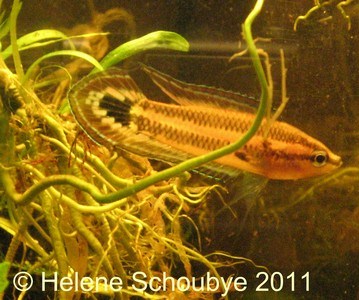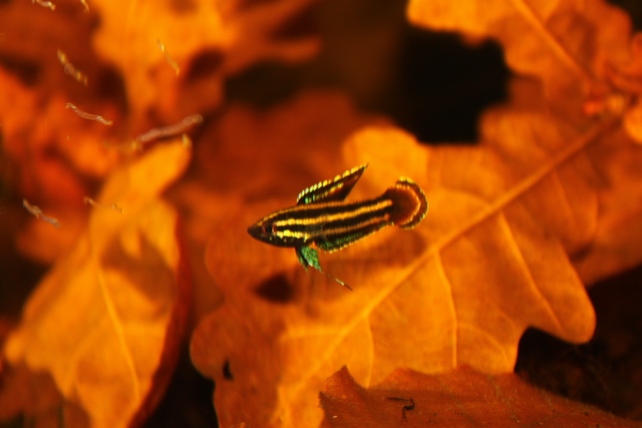
What you should know about these fish
No licorice gourami is longer than 5 cm, most hardly reach 4 cm in length. The largest species are P. quindecim (see photo right) and P. deissneri , also P. linkei, P. paludicola or the undescribed form of P. spec. Danau Rasau can sometimes reach almost 5 cm in length.
They are quiet fishes, which have only small territories in which a male focuses on a small cave made of leaves, wood or even an empty shell, which he occupies and defends. These caves can be located at some depth (up to two meters) or near the surface. You can get an idea of their small size, when you know that, for example, in the aquarium black plastic film canisters will be accepted. Into these, the male tries to lure a female. In the immediate vicinity of the cave, he courts her with spectacular fin displays and eventually spawns in the cave. Both partners collect the falling eggs and try to attach them to the cave ceiling where the male usually has collected few or no air bubbles. If the nest is complete, the female leaves the cave and defends the surrounding area.

The males of most species are much more colourful than the females. Their unpaired fins often display distinctive blue-green iridescent light strips that collect light and reflect it in the dark of the of the tea-colored water of jungle streams. Many species are similar and only differ by small features, others have larger, structural differences. The females, however, are very difficult to distinguish in most cases. Since we must assume that speciation is still an ongoing process in many forms, we must take care to ensure the animals do not mix. Community aquariums are advisable only for clearly structurally different species. In general, the fishes shall be kept in pairs or species aquarium.
But it’s not just about keeping. In the mass hobby most fish are actually kept only, in other words, consumed. When fish die, they will be bought and replaced. For rare, threatened fish like Parosphromenus this mindset is a luxury that we can not afford. A Parosphromenus friend has his fish not only to keep them, but to conserve them. Since their spectacular courtship and parental care is displayed only in suitably equipped aquarium, the friends of this fish always aim to breed them. In structurally rich, established tanks this process takes place almost without our help: often a small amount of young fishes will be raised by the parents.

